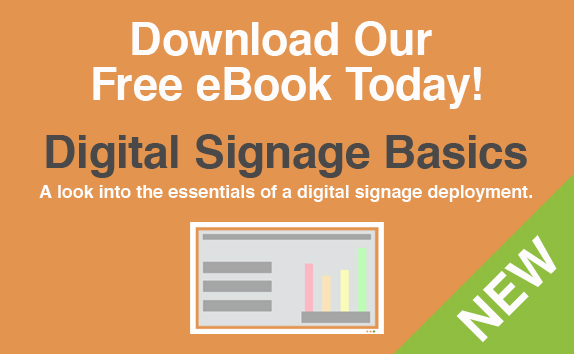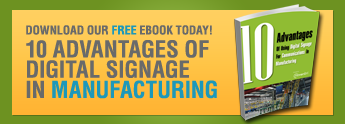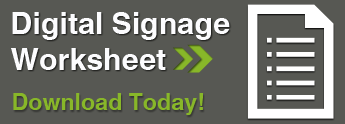001- What is Digital Signage?
Digital Signage – What is it? Why might I need it? How do I get it?
Our first podcast entertains these questions and more!
Transcript:
ML: We’d like to welcome everyone to our digital signage broadcast episode 100.
RM: No
ML: Okay, not 100? Alright. Uh, so we’re going to be discussing digital signage basics. A lot of questions out there when it comes to digital signage, so… This is Martin Lindsley. I just jumped off my desk…. and landed.
RM: Ugh, okay.
ML: Come on Robb, talk it through the first time. Robert Mullen there.
RM: This is some good stuff Martin. I think we’re going to get an award right off the bat for this episode. I’m Robert Mullen. Hello everyone.
ML: Excellent. So digital signage Robb. Let’s talk about that. People want to know what in the world is digital signage. What do you think? What do you got?
RM: Well, that’s the big question, isn’t it? I get calls all the time with people asking me “what is it?”, “where do I get it?”…. Or they’re trying to research it and they don’t know where to go. So, I thought, let’s do this podcast with Martin and tell everybody about it.
ML: Alright, well here’s the problem I run into.
RM: Right.
ML: My mother lives in a backwater town up in northern New England. She always asks me, “Well, what industry are you involved in, what work do you do?” And if I say I’m involved in digital signage, she goes, “What is that?” So Robb, help me explain to her. What in the world is digital signage?
RM: Digital signage is, basically, oh by the way, do you like how I took credit for the podcast all by myself?
ML: I have no problem with that whatsoever.
RM: Yeah, well, you know I felt bad.
ML: You’re gonna get all the hate mail anyways. It’s gonna come with this performance, so.
RM: Alright, so digital signage basically is electronic information displayed on an LCD display. That’s, in essence, what it is.
ML: What’s a LCD display? What do you mean?
RM: Well, that is, it’s very similar to what you have in your living room, which is a TV. You’ll see these displays hanging in places like hotels, or at, like, QSR restaurants like McDonalds or Burger King or something like that. You also see them in manufacturing. Maybe, if you go to the movies, you’ll see them there. Basically everywhere.
ML: So it’d be more like my TV, not my mom’s TV? Which is the…
RM: Well, yeah. She still has one of those…
ML: …big tube TV’s
RM: …yes…
ML: OK, gotcha.
RM: Right
ML: Alright, good. So you’re just basically gonna be showing messages on a flat screen TV, is kind of the basics of ‘what is digital signage’.
RM: Basically, yes.
ML: OK. Alright, so why would I need digital signage? What’s the big deal? A sign’s a sign, right? I can just get a poster board from the dollar tree and write on it what I need. Or get something printed out. Why do I need digital signage?
RM: Well, maybe you don’t need it, right? If all you need is a poster board with some stuff scribbled on it and you’re done with it. Maybe you doing a yard sale or something. You’re not going to see stop signs and yield signs out on the streets replaced with digital signage any time soon. But digital signage is for people who have a lot of communication that they want to do to a general public. For example at the restaurants, they’re gonna have digital signage used as menus. And those menus can be changed on a regular basis. Uh, you know, maybe once a week, once a day, depending on what they want to do.
ML: I order my value meal off a TV? Is that what you’re saying?
RM: Yes
ML: That’s genius.
RM: It is genius. It is genius. Also hotels use it to direct people where to go. You go in, you check in to your hotel and you don’t know where your meeting is. So Digital signage is gonna be there. It’s going to have the name of the group you’re going to visit. It’s gonna have the name of the room that you’re going to go to and the start and stop time. To print all that up would take a lot of time, a lot of paper. But if you can just put it up on the LCD, you can have that changed pretty quickly, pretty easily.
ML: So digital signage is putting the paper mills out of business?
RM: Not yet. It’s making life convenient for a whole lot of folks though.
ML: So… but it sounds like what you’re saying about digital signage is, mostly, it’s kind of like fluff. It’s there to like, dress up the place or give you a fancy way to display things. I mean, is there any real utilitarian use for digital signage?
RM: Well, digital signage does spruce up a place and it does make it look more modern and more professional but there’s a lot of real uses for digital signage. The main one is convenience and automation. For example if we go back to those hotels. A lot of those hotels keep all their information already in a database. It’s right there and ready to go. But no one can see it. It’s hard to get at. You have to be the manager or somebody to get into the computer system. The average guest can’t get there. But with digital signage, you could link that up to that same database and have that database automatically feed the digital signage every day, every hour, every minute. And now, instead of having to print up paper, you can have information that’s up there all the time. Automatically. Looking great.
ML: Well, alright, well let’s uh, let’s say I work in a paper mill uh… maybe I work in an auto parts manufacturer. Do I have any need for digital signage?
RM: Absolutely!
ML: Why?
RM: Again, trapped data. Data is in a database somewhere. Management wants its employees to see and employees are gonna want to see it. So if you’re working in a manufacturing environment, you’re making a thing. You’re making it over and over and over and you have goals and you have numbers that you want to hit every day. You can tie your real numbers that are kept in a database to the digital signage. The digital signage is going to show that information on the screen so that when you are working throughout the day you can see whether or not you are keeping up with the pace that’s required, or if you’re falling behind you need to make changes, or if you’re going really fast, you can see that as well.
ML: So if Tommy Callahan had had digital signage in his factory, they wouldn’t have to shut down the brake pad division, correct?
RM: That’s right. It would have saved a lot of jobs.
ML: And Tommy Boy would have continued to be the great movie that it has been today.
RM: Yes, that’s right.
ML: I was wondering if you were gonna catch the pop culture reference there.
RM: Yes.
ML: Alright, great. So we got digital signage, why need it, some uses of it. Again, it seems to be all very, kind of like high level stuff that, you know, you’re not getting into the nuts and bolts of what, maybe specific industries, all that would entail. So what are the parts and pieces that I might need? Let’s say I… I’m a manufacturing company.
RM: Okay.
ML: And I’ve been charged with putting together some type of digital signage rollout. What in the world do I need to get? What do I start with? You already said I need a TV and I need something to put on it, but what are the parts and pieces?
RM: Well, there’s uh, uh… That’s a pretty big question. Probably even worthy of its own show. But I can talk about some of the basic elements of all that. So, obviously, one of the parts you’re going to need is an LCD display. And uh…
ML: TV, not a tube TV?
RM: That’s right.
ML: Okay.
RM: A flat screen, 16:9, HDTV.
ML: I could use a tube TV, right? It just would be better.
RM: Yes, you could use a tube TV and you could also use just a PC or you could use a thumb drive and all that but…
ML: I could use it to heat up my sandwich.
RM: You could. You know in Japan you can get little thumb drives that light cigarettes too.
ML: Really?
RM: Yes, it’s pretty cool.
ML: Man, what will they think of next? I saw Gung Ho, I don’t remember seeing that in there.
RM: No. Uh, well, you missed out. So anyway, you’re going to need an LCD display. A tube TV really is impractical because of the size and the weight and they don’t make them anymore, really. And you’re going to need some sort of player. Some sort of device that’s going to send the signal to the LCD.
ML: Don’t they have TV’s with that stuff kind of built in?
RM: They do.
ML: That seems to make sense. That’s my million dollar idea.
RM: That’s right.
ML: That already happened.
RM: That’s right. You could replace, you know, all kinds of things with that. Uh, you know… Well, actually what you bring up is a… digital signage actually has many levels of need or professional requirements. So if you’re operating a one person store, you’re operating a deli or you’re a little store somewhere, and you’re going to change you’re information on that screen once a month, or once every six months or something like that, then perhaps a consumer grade TV that does play a thumb drive will work for you because you’re not gonna need to make changes very often. You want the look of a digital sign but you don’t want to have to worry about any of the automation or the extra stuff that goes along with it, then that’s great. I encourage you to do that.
ML: I can’t get high speed internet over my antenna.
RM: That’s right.
ML: So I don’t need that.
RM: So, no networking, just, you know, you make it on Photo Shop or Microsoft Paint or something and you’re done.
ML: What about PowerPoint?
RM: PowerPoint, yes.
ML: That’s… I learned that in school, PowerPoint, I can at least do Power Point, so…
RM: You?
ML: So I can just throw that out if I’m a little mom and pop type operation. There’s digital signage even for us types.
RM: Well.
ML: Make fun of my ma and pa…
RM: OK, well, and then the other end of the spectrum would be like a really large factory or a multi-state or even multi-country rollout of digital signs. So perhaps if you had a factory floor with say 50 screens. Or even just 25 screens. You’re gonna want to have a little more connectivity going on there. Especially if these screens are mounted 25 feet up in the air or if you have to get a man lift out to get up there and change something. You’re gonna want to network all the screens and the players and everything to a central source so that they can be managed at one place easily.
ML: So that will keep me from having to get a ladder out and run up to each TV, put in a thumb drive…
RM: Right.
ML: Risk all those OSHA violations….
RM: Correct.
ML: Things like that.
RM: Correct. You would never do it, by the way. It would be, it would be too big of a job. No one would do it. The screens would fall into disuse. So having them networked and working on a central server that way would be the better way to go. And so the elements that go along with that are, of course, the LCD…
ML: Uh huh.
RM: You gonna make another CRT joke?
ML: No, I’m done with those. Those are retired.
RM: OK. So, then you need a player. Some sort of player that will either mount on the back of the TV or maybe go in a central location. Then you need all sorts of cabling to make it all work. Different solutions require different cables. And then you’re gonna need software. Software to manage the whole thing.
ML: That actually is starting to sound a little bit complicated now. Which, I guess, complicated can be good if it doesn’t affect me as an end user.
RM: Well yes, it can be complicated. The better digital signage systems really tone down that complication, or the difficulty, implementing all that. Many digital signage companies will help you install that or manage it, so that, depending on your own skillset, you can still have a fantastic, sophisticated system up and running without having to be an IT genius.
ML: My VCR still blinks 12 o’clock.
RM: Your VCR… yes.
ML: That’s all I’m saying.
RM: Does anybody out there still have a VCR?
ML: My mom.
RM: Yeah, okay.
ML: And CRT TV’s. Come on, you know that… Alright, well good. That kind of gives me a rounded out view I guess, of where we can get digital signage from us, uh, what do we need for digital signage. Where do we get it from? That’s actually what I really want to know. Am I gonna be going down to the box store and buying my digital signage off the shelf? Do I gotta put all these pieces together? How is that going to translate for me.
RM: It’s easy. All you do is google ‘digital signage’ and you’ll find one of a handful of companies that will sell you a great system.
ML: Awesome. Google’s incredible, Robb.
RM: I’m just kidding. Actually, it’s kind of a nightmare finding a digital signage company because there’s a million of them out there. There’s just so many. So where do you get it really, kind of, goes back to what are you going to use it for. If you are that mom and pop, small kind of location, you go to Best Buy or something to… (computer ding)… um..
ML: Somebody just decided to buy some right now.
RM: Yeah, I know. It came out of the email.
ML: Very nice.
RM: I’m going to move that over here…. So, you go to your mom and pop, you know, place like that. You get a screen from Best Buy with a thumb drive capability and then you make your content and you put it on the screen and you’re done. If you’re that manufacturing location, you’re going to want to find a company that can handle what you’re doing. So for them, I would google something like ‘manufacturing digital signage’. Something like that so that you can find the right stuff that you’re looking for. And ask a lot of questions.
ML: So there is help out there.
RM: There is help out there.
ML: And we’re starting to see digital signage more and more. Even though I made kind of reference to northern New England and my home town up there has one blinking light. But they do have a couple restaurants, they have fast food places, and they actually have digital menu boards up there. So now, at least when I go home I can, “hey, that’s what I do.” I work in that industry.
RM: Oh, fantastic.
ML: Very good Robb. Well thanks so much. You’ve helped me out a lot here and, uh, as far as going through some of these basics. We’d like to thank everybody who tuned in and listened to the podcast. If you’d like some more information on digital signage, we even have a digital signage worksheet that you can download from our website www.noventri.com, go to our resources page and we have digital signage downloads. There you’ll find a digital signage worksheet. It gives you a bunch of questions to ask when you’re going to deal with any digital signage companies, as far as some things you might want to look for, and some features you may need for your digital signage rollout. And if you forget what digital signage is, what can they do Robb?
RM: Just ask me.
ML: Ask you. And they can go back and listen to this podcast.
RM: That’s right.
ML: Alright. Sounds good. So we’ll look forward to our next one and on that one I think the topic we have chosen is “What’s the difference between consumer and commercial digital signage?”




